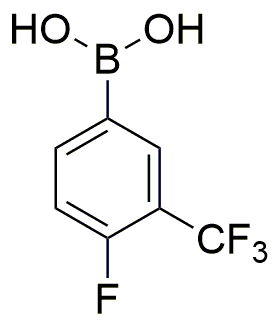4-Fluoro-3-(trifluoromethyl)phenylboronic acid is widely utilized in research focused on:
- Pharmaceutical Development: This compound plays a crucial role in the synthesis of various pharmaceuticals, particularly in creating compounds that target specific biological pathways, enhancing drug efficacy.
- Organic Synthesis: It serves as a versatile building block in organic chemistry, allowing researchers to create complex molecules with precision, which is essential for developing new materials and chemicals.
- Materials Science: The compound is used in the production of advanced materials, including polymers and coatings, which benefit from its unique chemical properties, leading to improved durability and performance.
- Fluorinated Compounds: It is instrumental in the preparation of fluorinated compounds, which are valuable in various applications, including agrochemicals and specialty chemicals, due to their enhanced stability and reactivity.
- Analytical Chemistry: This boronic acid derivative is utilized in analytical methods for detecting and quantifying specific biomolecules, proving essential in fields like biochemistry and environmental science.
General Information
Properties
Safety and Regulations
Applications
4-Fluoro-3-(trifluoromethyl)phenylboronic acid is widely utilized in research focused on:
- Pharmaceutical Development: This compound plays a crucial role in the synthesis of various pharmaceuticals, particularly in creating compounds that target specific biological pathways, enhancing drug efficacy.
- Organic Synthesis: It serves as a versatile building block in organic chemistry, allowing researchers to create complex molecules with precision, which is essential for developing new materials and chemicals.
- Materials Science: The compound is used in the production of advanced materials, including polymers and coatings, which benefit from its unique chemical properties, leading to improved durability and performance.
- Fluorinated Compounds: It is instrumental in the preparation of fluorinated compounds, which are valuable in various applications, including agrochemicals and specialty chemicals, due to their enhanced stability and reactivity.
- Analytical Chemistry: This boronic acid derivative is utilized in analytical methods for detecting and quantifying specific biomolecules, proving essential in fields like biochemistry and environmental science.
Documents
Safety Data Sheets (SDS)
The SDS provides comprehensive safety information on handling, storage, and disposal of the product.
Product Specification (PS)
The PS provides a comprehensive breakdown of the product’s properties, including chemical composition, physical state, purity, and storage requirements. It also details acceptable quality ranges and the product's intended applications.
Certificates of Analysis (COA)
Search for Certificates of Analysis (COA) by entering the products Lot Number. Lot and Batch Numbers can be found on a product’s label following the words ‘Lot’ or ‘Batch’.
*Catalog Number
*Lot Number
Certificates Of Origin (COO)
This COO confirms the country where the product was manufactured, and also details the materials and components used in it and whether it is derived from natural, synthetic, or other specific sources. This certificate may be required for customs, trade, and regulatory compliance.
*Catalog Number
*Lot Number
Safety Data Sheets (SDS)
The SDS provides comprehensive safety information on handling, storage, and disposal of the product.
DownloadProduct Specification (PS)
The PS provides a comprehensive breakdown of the product’s properties, including chemical composition, physical state, purity, and storage requirements. It also details acceptable quality ranges and the product's intended applications.
DownloadCertificates of Analysis (COA)
Search for Certificates of Analysis (COA) by entering the products Lot Number. Lot and Batch Numbers can be found on a product’s label following the words ‘Lot’ or ‘Batch’.
*Catalog Number
*Lot Number
Certificates Of Origin (COO)
This COO confirms the country where the product was manufactured, and also details the materials and components used in it and whether it is derived from natural, synthetic, or other specific sources. This certificate may be required for customs, trade, and regulatory compliance.


